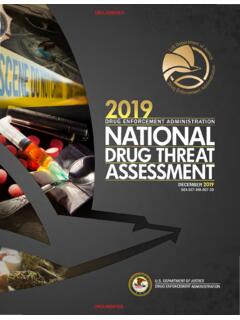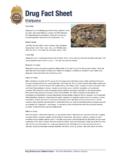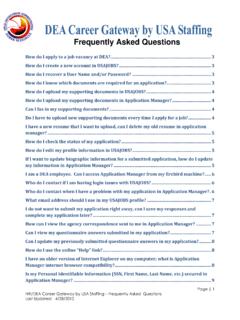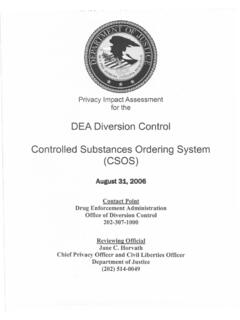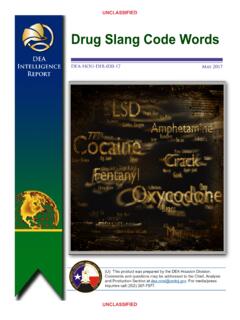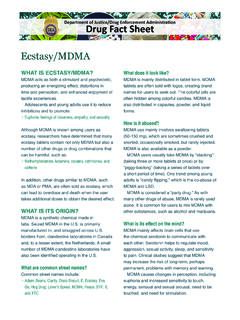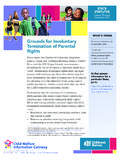Transcription of The Drug Enforcement Administration (DEA) 1980-1985
1 DRUG Enforcement Administration History 1980-1985 During the early 1980s, international drug trafficking orga-nizations reorganized and began operating on an unprecedented scale. The rise of the Medellin cartel, the influx of cocaine into the , and the violence associated with drug trafficking and drug use complicate the task of law Enforcement at all levels. Violent crime rates rose dramatically during this period and continued to rise until the early 1990s. The normalization of drug use during the previous two decades continued as the population rediscovered cocaine. Many saw cocaine as a benign, recreational drug. In 1981, Time magazine ran a cover story en-titled, High on Cocaine with cover art of an elegant martini glass filled with cocaine.
2 The article reported that cocaine s use was spreading quickly into America s middle class: is the drug of choice for perhaps millions of solid, conven-tional and often upwardly mobile citizens. Drug abuse among citizens in the early 1980s remained at dangerously high levels. The 1980 arrest of Leroy Butler, one of the most significant heroin traffickers in New York City, also led to the seizure of the $40,000 Rolls Royce shown here. Posing with the cars are, from left: SA Lewis Rice, SA Thor Nowozeniuk, and GS Fred Gormandy 49 History Members of the Mexico City Management Team, June 1980, back row, left to right: CA Rudy Ramirez, Costa Rica CO; RAC Richard Canas, Monterey RO; RAC Ruben Salinas, Mazatlan RO; CA Guatemala; RAC William Rochon, Guadalajara RO; RAC William Farnan, Merida RO; and RAC Thomas Telles, Hermosillo RO. Front row: GS Charlie Lugo; Mexico City Asst.
3 Regional Director Frank Macolini, Mexico City; DEA Administrator Peter Bensinger; Regional Director Edward Heath, Mexico City; and GS Frank Cruz, Mexico City. The Rise of the Medellin Cartel By the early 1980s, the drug lords of the Medellin cartel were well established in Colombia, where they used murder, intimida tion, and assassination to keep journalists and public officials from speaking out against them. Law Enforcement officers and judges were favored targets of these brutish drug cartels that controlled entire towns and economies to support their criminal business. By 1985, Colombia had the highest murder rate in the world. In Medellin alone, 1,698 people were murdered, and the follow ing year, that number more than doubled to 3,500. The Medellin cartel was fast becoming the richest and most feared underworld crime syndicate the world had ever encountered. During the period 1980 through 1985, the Medellin mafias delivered to the a large measure of the wholesale violence and terror that their drug trafficking activities had inflicted on their home country.
4 In a grim parody of their campaign to control Colombia, they insinuated themselves into legitimate, and useful, sectors of the economy, such as the banking and import in dustries. The suffered badly from the cartel s presence as local drug gangs began to form, communities were terrorized, and drug use among teens continued to climb. Colombian Marijuana Colombian marijuana continued to be a problem in the early 1980s as Colombia-based traffickers brought boatloads of high-potency marijuana to the shores of the Consequently, the DEA ran several investigations targeting these smugglers, includ ing Operations Grouper and Tiburon. In 1981, Operation Grouper was conducted in cooperation with the Coast Guard and 21 other federal, state, and local government agencies. It was one of the largest Enforcement opera tions launched against marijuana traffickers from Colombia. The operation targeted 14 separate florida , Louisiana, and Geor gia-based trafficking organiza tions that were smuggling large-scale, multi-ton quantities of marijuana and millions of dos age units of methaqualone into the For 22 months, nine DEA special agents operated undercover, some posing as off-loaders to a number of smug gling organizations.
5 The smug gling network had negotiated deliveries to states as far away as Maine and New York. As a result of the operation, agents ultimately arrested 122 out of the 155 indicted subjects, and seized more than $1 billion worth of drugs, and $12 mil lion worth of assets, including 30 vessels, two airplanes, and $1 million in cash. The following year, DEA concluded Operation Tibu ron, another major operation targeting marijuana smuggling from Colombia. Tiburon resulted in the arrest of 495 people and the seizure of 95 vessels, million pounds of marijuana in the , and million pounds of marijuana in Colombia. At torney General William French Smith praised this operation as a classic example of how agencies, and indeed entire governments, can work together sharing intelligence and expertise and zeroing in on the sea and air routes used by major smugglers.
6 Operation Swordfish (1980) In December 1980, DEA launched a major investigation in Miami aimed against international drug organizations. The op eration was dubbed Operation Swordfish because it was intended to snare the big fish in the drug trade. DEA set up a bogus money laundering operation in suburban Miami Lakes that was called Dean International Investments, Inc. DEA agents teamed up with a Cuban exile who had fallen on hard times and was will ing to lure Colombian traffickers to the bogus bank. In addition to spending time in Cuban prisons after the Bay of Pigs invasion, the exile had also served jail time in the for tax fraud and was heavily in debt to the Internal Revenue Service. During the 18-month investigation, agents were able to gather enough evidence for a federal grand jury to indict 67 and Colombian citizens. At the conclusion of the operation, drug agents seized 100 kilos of cocaine, a quarter-million methaqualone pills, tons of marijuana, and $800,000 in cash, cars, land, and Miami bank accounts.
7 Operation Swordfish was a significant attack on South florida s flourishing drug trade. International Security & Development Cooperation Act of 1981 The International Security and Development Act, Public Law 97-113, was passed in 1981. Among its provisions, this act au 50 thorized appropriations for the International Narcotics Control program under section 482 of the Foreign Assistance Act, specifi cally, $ million for each of the fiscal years 1982 and 1983. The act allowed for the use of herbicides in drug crop eradication while requiring the Secretary of Health and Human Services to monitor any potentially harmful impacts of the use of such her bicides. Finally, the act directed the President to make an annual report to Congress on policy for establishing an internation al strategy to prevent narcotics trafficking. This mandated report was the forerunner of the International Narcotics and Controlled Strategy Report (INCSR), which the President issues every March and which highlighted the drug control efforts in every foreign country that receives aid from the Concurrent Jurisdiction with the FBI (1982) In January 1982, Attorney General William French Smith an nounced a federal law Enforcement reorganization.
8 In an effort to bolster the drug effort with more anti-drug manpower and resources, the FBI officially joined forces with the DEA. DEA would continue to be the principal drug Enforcement agency and continue to be headed by an administrator, but instead of report ing directly to Associate Attorney General Rudy Giuliani, as Ad ministrator Bensinger had, Administrator Mullen would report to FBI Director William H. Webster. Therefore, the FBI gained concurrent jurisdiction with the DEA over drug offenses. This increased the human and technical resources available for federal drug law Enforcement from 1,900 agents to almost 10,000. Administrator Mullen was the first FBI special agent to head the DEA. The Administration intended to increase cooperation between the two agencies by combining the street savvy of DEA agents with the variety of unique FBI investigative skills, espe cially in the area of money laundering and organized crime.
9 During the previous summer, high-ranking Justice Depart ment officials had formed a committee to study the most effec tive method of coordinating the efforts of the DEA and FBI. Although the committee had considered an outright merger of the two agencies, they decided that formalizing a closer working relationship would be the most effective way to enhance the na tion s drug fighting effort. In order to implement concurrent investigations, the two agen cies began an intensive cross-training program, and similar pro grams were established to coordinate intelligence gathering efforts and laboratory analyses. Several DEA executives were reassigned to make room for additional FBI agents who assumed managerial responsibility for the DEA. Over time, FBI and DEA shared many administrative prac tices, and the years between 1981 and 1986 proved to be a time of growth and development for both agencies.
10 The DEA expanded its global responsibilities and placed greater emphasis on conspiracy and wiretap cases. Southwest Asian Heroin After years of aggressive law Enforcement efforts aimed against heroin traffickers, sev eral significant benefits were achieved. Dur ing the 1970s, the heroin addict popula tion was reduced from over a half million to 380,000 addicts; heroin overdose deaths dropped by 80 percent; and heroin-related History injuries decreased by 50 percent. In 1981, it was estimated that there was 40 percent less heroin available than in 1976. But, by the early 1980s, a new wave of heroin from the poppy fields of the Golden Crescent countries in southwest Asia primar ily Iran, Afghanistan, and Pakistan began to flood the East Coast. Heroin traffickers reopened the notorious French Connection drug route of the 1960s, using many of the same organized crime smugglers in Italy, France, and West Germany.
